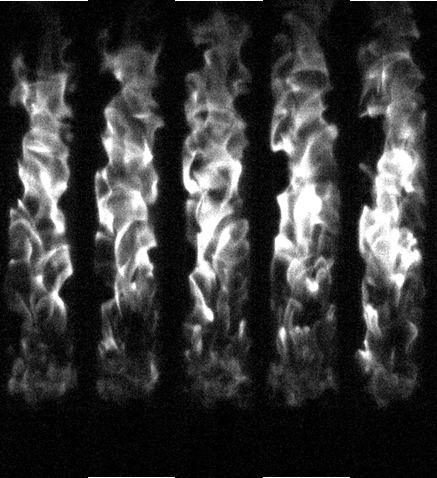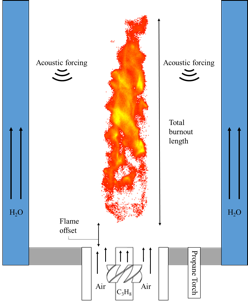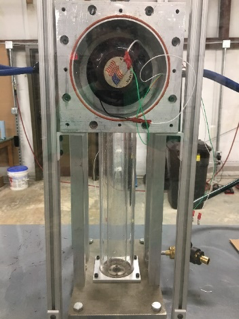 Non-premixed combustors offer significant operational advantages in terms of the flame stability. Flashback is impossible due to the lack of a combustible mixture upstream. Additionally, blowoff is unlikely at operational velocities, since a combustible mixture is achieved downstream. Achieving high efficiency combustion in non-premixed combustors requires thorough mixing of the oxidizer and fuel streams. In order to achieve this mixing, swirl is frequently introduced to enhance mixing. Additionally, oxygen-methane combustion is seeing renewed interest in rocketry, with companies such as SpaceX developing oxygen-methane engines for Mars applications.
Non-premixed combustors offer significant operational advantages in terms of the flame stability. Flashback is impossible due to the lack of a combustible mixture upstream. Additionally, blowoff is unlikely at operational velocities, since a combustible mixture is achieved downstream. Achieving high efficiency combustion in non-premixed combustors requires thorough mixing of the oxidizer and fuel streams. In order to achieve this mixing, swirl is frequently introduced to enhance mixing. Additionally, oxygen-methane combustion is seeing renewed interest in rocketry, with companies such as SpaceX developing oxygen-methane engines for Mars applications. The swirl-stabilized combustion facility is designed to investigate the effect that swirling the oxidizer and fuel streams have on the flame response in an oxygen-methane flame. Lean, non-premixed swirl stabilized combustors have demonstrated a proclivity towards the development of combustion instabilities. In rocket engines these instabilities can be up to 1000% of the mean chamber pressure, leading to the destruction of the engine. The heat release response of a swirled, oxygen-methane flame is measured using a variety of optical diagnostics and advanced data reduction techniques. In addition, dynamic pressure measurements are taken to allow for examination of the acoustic response of the combustion chamber. The combination of the heat release measurements, and acoustic pressure measurement allow for calculation of the heat release transfer function, which can help to elucidate the fundamental mechanisms for the development of these combustion instabilities.
The swirl-stabilized combustion facility is designed to investigate the effect that swirling the oxidizer and fuel streams have on the flame response in an oxygen-methane flame. Lean, non-premixed swirl stabilized combustors have demonstrated a proclivity towards the development of combustion instabilities. In rocket engines these instabilities can be up to 1000% of the mean chamber pressure, leading to the destruction of the engine. The heat release response of a swirled, oxygen-methane flame is measured using a variety of optical diagnostics and advanced data reduction techniques. In addition, dynamic pressure measurements are taken to allow for examination of the acoustic response of the combustion chamber. The combination of the heat release measurements, and acoustic pressure measurement allow for calculation of the heat release transfer function, which can help to elucidate the fundamental mechanisms for the development of these combustion instabilities. 
Currently, there is no rational design framework for the elimination of combustion instabilities, leading to time-consuming “cut-and-try” design methodologies which also prove costly. Other research has focused on only one aspect of the combustion instability problem, or focused on other types of fuel-oxidizer systems. The novel design of the speaker housing allows for acoustic forcing in both the longitudinal and transverse directions, providing a comprehensive investigation into various, more realistic acoustic fields present imposed on a rocket injector.
